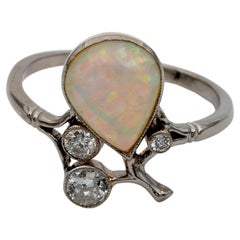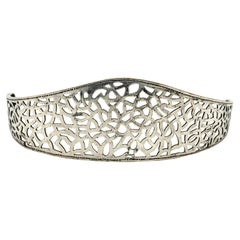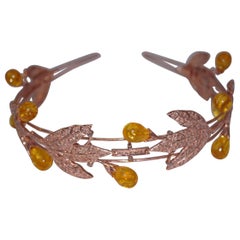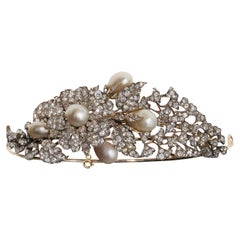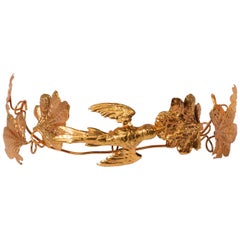Art Nouveau Tiara
Antique Early 1900s French Art Nouveau More Jewelry
Diamond, Opal, 18k Gold
Early 20th Century European Art Nouveau Cluster Rings
Diamond, Opal, 18k Gold
Antique 1890s English Art Nouveau Vanity Items
Silver
2010s Indian Art Nouveau Choker Necklaces
Amber, Diamond, Sterling Silver
Recent Sales
Antique Early 1900s Art Nouveau More Jewelry
Diamond, Natural Pearl, 18k Gold, Silver
Antique Early 1900s Unknown Art Nouveau More Jewelry
Base Metal
Vintage 1910s Unknown Art Nouveau More Jewelry
Moonstone, Silver
Antique Late 19th Century Chinese Art Nouveau More Jewelry
Jade, Tourmaline
2010s Indian Art Nouveau Choker Necklaces
Amber, Diamond, Sterling Silver
Antique Late 19th Century Unknown Art Nouveau Engagement Rings
White Diamond, 18k Gold, Platinum
People Also Browsed
21st Century and Contemporary Unknown Engagement Rings
Diamond, Platinum
Antique Early 1900s German Art Nouveau Cluster Rings
Sapphire, Diamond, 18k Gold, Silver, 14k Gold
1910s French Suitcases and Trunks
Vintage 1970s German Jugendstil Beaded Necklaces
Diamond, Pearl, 18k Gold, White Gold
Early 2000s British Cocktail Dresses
21st Century and Contemporary American Contemporary Cocktail Rings
Diamond, Emerald, 14k Gold, Yellow Gold, Gold
2010s Turkish Modern Engagement Rings
Diamond, Opal, Black Opal, 14k Gold
Late 20th Century American Contemporary Engagement Rings
Diamond, Platinum
1920s American Hats
1920s French Evening Bags and Minaudières
1990s French Evening Dresses and Gowns
1960s French Evening Dresses and Gowns
Early 2000s French Capes
1990s Italian Cocktail Dresses
21st Century and Contemporary Italian Choker Necklaces
Diamond, 18k Gold, White Gold
Early 2000s Italian Blouses
Art Nouveau Tiara For Sale on 1stDibs
How Much is a Art Nouveau Tiara?
The Legacy of Diamond in Jewelry Design
Antique diamond rings, diamond tiaras and dazzling vintage diamond earrings are on the wish lists of every lover of fine jewelry. And diamonds and diamond jewelry are primarily associated with storybook engagements and red-carpet grand entrances — indeed, this ultra-cherished gemstone has a dramatic history on its hands.
From “A Diamond Is Forever” to “Diamonds Are a Girl’s Best Friend,” pop culture has ingrained in our minds that diamonds are the most desired, the most lasting and the most valuable gemstone. But what makes the diamond so special? Each stone — whether it’s rubies, sapphires or another stone — is unique and important in its own right. April babies might claim diamonds for themselves, but just about everyone wants this kind of sparkle in their lives!
There are several factors that set diamonds apart from other stones, and these points are important to our gem education.
Diamonds are minerals. They are made up of almost entirely of carbon (carbon comprises 99.95 percent; the remainder consists of various trace elements). Diamonds are the hardest gemstones, ranking number 10 on the Mohs Hardness Scale. Even its name, diamond, is rooted in the Greek adamas, or unconquerable. The only object that can scratch a diamond is another diamond. Diamonds are formed deep within the earth at very high temperatures (1,652–2,372 degrees Fahrenheit at depths between 90 and 120 miles beneath the earth’s surface) and are carried up by volcanic activity. Diamonds are quite rare, according to the Gemological Institute of America, and only 30 percent of all the diamonds mined in the world are gem quality.
In the 1950s, the Gemological Institute of America developed the 4Cs grading system to classify diamonds: clarity, color, cut and carat weight. Not all diamonds are created equal (there are diamonds, and then there are diamonds). The value of the diamond depends on the clarity (flawless diamonds are very rare but a diamond's value decreases if there are many blemishes or inclusions), color (the less color the higher the grade), cut (how the diamond’s facets catch the light, certain cuts of diamonds show off the stone better than others) and carat weight (the bigger, the better).
When you start shopping for a diamond engagement ring, always prioritize the cut, which plays the largest role in the diamond's beauty (taking the time to clean your diamond ring at least every six months or so plays a role in maintaining said beauty). And on 1stDibs, a range of buying guides can be found for those in the market for antique engagement rings, vintage engagement rings or Art Deco engagement rings.
Shop antique and vintage diamond rings, diamond necklaces and other extraordinary diamond jewelry on 1stDibs.
- What is Art Nouveau jewelry?1 Answer1stDibs ExpertNovember 2, 2021Art Nouveau jewelry generally featured three main themes: flora, fauna and women. The Art Nouveau movement lasted 15 years and it reached its pinnacle in the year 1900. Art Nouveau jewelers used every “canvas” imaginable, looking beyond brooches and necklaces to belt buckles, fans, tiaras, dog collars (a type of choker necklace), pocket watches, corsages and hair combs. Multicolored gems and enamel could complete this vision better than diamonds. Enameling is most often associated with Art Nouveau jewelry, specifically plique-à-jour. Known as backless enamel, plique-à-jour allows light to come through the rear of the enamel because there is no metal backing. It creates an effect of translucence and lightness. Shop a collection of antique and vintage Art Nouveau jewelry from some of the world’s top jewelers on 1stDibs.
- Where did Art Nouveau originate?1 Answer1stDibs ExpertMay 14, 2024Art Nouveau originated in France and Great Britain, but variants materialized elsewhere. The visual vocabulary of Art Nouveau was particularly influenced by the soft colors and abstract images of nature as portrayed in Japanese art prints, which arrived in large numbers in the West after open trade was forced upon Japan in the 1860s. Impressionist artists were moved by the artistic tradition of Japanese woodblock printmaking and other modes of art and design in the East Asian country. The Art Nouveau style quickly reached a wide audience in Europe via advertising posters, book covers, illustrations and other work by such artists as Aubrey Beardsley, Henri de Toulouse-Lautrec and Alphonse Mucha. While all Art Nouveau designs share common formal elements, different countries and regions produced their own versions. Explore a selection of Art Nouveau furniture, jewelry and art on 1stDibs.
- 1stDibs ExpertFebruary 27, 2024Art Nouveau was influenced by a few things. The soft colors and abstract images of nature seen in Japanese woodblock prints, which arrived in large numbers in the West after open trade was forced upon Japan in the 1860s, were a major source of inspiration. Also, Pre-Raphaelite art and the Arts and Crafts and Rococo styles had an influence on Art Nouveau designers. On 1stDibs, find a wide range of Art Nouveau furniture and decorative objects.
- What is Art Nouveau furniture?1 Answer1stDibs ExpertAugust 15, 2019
Art Nouveau furniture was a style of furniture that emerged at the end of the 19th century and was characterized by its complex curved lines. The curved details in the furniture were typically carved by hand and finished with lacquer. The unmistakable gloss that is associated with Art Nouveau comes from the thick coat of varnish applied to the furniture as the final step of the production process.
- Why did Art Nouveau end?1 Answer1stDibs ExpertAugust 8, 2024Art Nouveau ended primarily due to world events. When World War I broke out in 1914, artistic production was largely halted in order to free up materials for manufacturing equipment for the war effort. By the time the 1919 Treaty of Versailles brought about the end of the war, interest in Art Nouveau had waned. Designers and artists became interested in new forms and styles, such as Art Deco. On 1stDibs, explore a diverse assortment of Art Nouveau furniture, decorative objects, jewelry and art.
- 1stDibs ExpertAugust 15, 2019
The main difference between Art Nouveau and Art Deco is that the former is detailed and ornate, and the latter is sharp and geometrical. When the movement started at the end of the 19th century, Art Nouveau was heavily influenced by nature and the curved lines of flowers. Art Deco, which became popular in the beginning of the 20th century, was inspired by the geometric abstraction of cubism.
- 1stDibs ExpertApril 5, 2024No one person created the Art Nouveau movement. However, the term debuted in an 1884 article in the L'Art Moderne journal, describing the work of a collective of artists known as Les XX. As a result, some people credit the group and its founding members, James Ensor and Théo van Rysselberghe, as helping to define the movement. However, Art Nouveau was heavily informed by work that came before, including Rococo design, Pre-Raphaelite art, Japanese art and the Arts and Crafts movement. Beyond Les XX, a number of creators helped to propel the movement. Among them were Charles Rennie Mackintosh, Louis Majorelle, Émile Gallé, Antoni Gaudí and Tiffany Studios. On 1stDibs, explore a diverse assortment of Art Nouveau furniture and decorative objects.
- 1stDibs ExpertAugust 15, 2019
The Art Nouveau design movement used such materials as cast iron and steel, ceramic and glass. This style of architecture, design, art and jewelry was characterized by its use of long, sinuous lines that are reflected in nature.
- Is stained glass Art Nouveau?1 Answer1stDibs ExpertApril 5, 2022Yes, some stained glass is Art Nouveau. It was during this period that Louis Comfort Tiffany produced his famed stained glass windows and decorative objects. However, the tradition of producing stained glass traces all the way back to the Gothic period. You'll find a selection of stained glass on 1stDibs.
- 1stDibs ExpertApril 5, 2022Alphonse Mucha was a Czech painter who is one of the originators of the Art Nouveau style. His style of painting and design rose in popularity in 1895 and he produced many works, including illustrations, posters and jewelry designs. Find a variety of Alphonso Mucha art and prints on 1stDibs.
- 1stDibs ExpertAugust 20, 2024To identify Art Nouveau jewelry, first consider its overall shape and themes. Flora, fauna and female figures were the three main themes in Art Nouveau jewelry. Winged creatures, such as insects and birds, were also popular subjects. Next, examine the materials and techniques. Art Nouveau jewelers distinguished themselves from their predecessors through the use of their unorthodox materials and methods. Prior to the 20th century, artisans working with jewelry prioritized precious metals and diamonds. This was not true for Art Nouveau creators. Enameling is most often associated with Art Nouveau jewelry, specifically plique-à-jour. Known as backless enamel, plique-à-jour allows light to come through the rear of the enamel because there is no metal backing. It creates an effect of translucence and lightness. Art Nouveau jewelers also favored pearls, particularly baroque pearls, for their large size and irregular shape. However, opal was the most popular stone, and Art Nouveau jewelry was primarily set in yellow gold. If you need more help identifying your jewelry, a certified appraiser or knowledgeable dealer can assist you. On 1stDibs, find a wide range of Art Nouveau jewelry.
- 1stDibs ExpertNovember 4, 2024To identify Art Nouveau furniture, first try to locate a maker's mark on the piece. You can then use it to research the maker with the help of information published in trusted online resources. Some makers, such as Charles Rennie Mackintosh, Louis Majorelle and Émile Gallé, are well-known for their Art Nouveau furnishings. If you determine that a maker identified with Art Nouveau produced your piece, it likely reflects the movement's characteristics, especially if it was made during the late 19th or early 20th centuries. You can also look for common features of Art Nouveau furniture, such as sinuous, organic and flowing lines; forms that mimic flowers and plant life; decorative inlays and ornate carvings of natural-world motifs such as insects and animals and the use of hardwoods such as oak, mahogany and rosewood. A certified appraiser or knowledgeable antique dealer can aid you with the identification process. Shop a diverse assortment of Art Nouveau furniture on 1stDibs.

